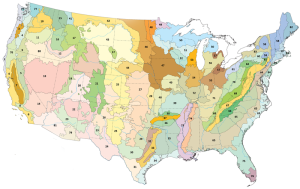On our recent trip to Hawaii, we got to do a lot of hiking. Nothing too serious, but we did try to do at least short hikes each day. We were fairly successful when it wasn’t raining.
One of our first hikes was on Oahu, on the Old Pali Highway. This route leads along a decommissioned road that run between Honolulu and the Windward side of Oahu.

Oahu was formed by two volcanoes, which have now eroded to form the western Wai’anae and eastern Ko’olau mountains. Millions of years ago, about half of the Ko’olau volcano slid off in a massive landslide, creating a 100-mile long debris field under the ocean to the northeast, and leaving a long, tall series of cliffs on the remaining above-water part of the volcano. This cliff (the Pali) limits travel between the coastal Windward side of the island and the plateau between the Wa’anae and Ko’olau ranges.

The Old Pali Highway takes advantage of a slight gap in the range, where there is only about a 1000-foot vertical cliff between the two sides, rather than the ~2400-foot cliff that’s found elsewhere. However, this road was always wet, steep, narrow, and dangerous to travel. It was eventually replaced by the (new) Pali Highway, which is larger and uses two tunnels and a set of ramps to make the current highway less steep. Hikers can take the Old Pali highway from its high point at the Pali Overlook down to where it connects with a state trail to a waterfall.

When walking on the Old Pali Highway, you can really get a sense for how much more sketchy this connection between the two sides of the island was at the time. Water constantly seeps onto the road from the porous basalt, and ferns and other plants abound. The hike gives you views into some pretty gorgeous valleys that aren’t visible form the new road.

We hiked this as a loop from the top down, then back up. We did go a bit onto the waterfall trail, but it was starting to get dark (and we were hearing wild pigs), so we went back up.

There are some interesting birds on this trail, but not much that’s native: it lies within the range of avian malaria-carrying mosquitoes that have decimated most native forest bird species in Hawaii. Within the mosquito zone, there are pretty much no more native forest birds. Scientists are quite concerned about the effect of global warming on Hawaiian forest birds: mosquitoes are limited to lower elevations because of cold mountain air. As the climate warms, their zone of infiltration expands up into the former mountain refuges of the birds, who have no immunity to avian malaria.

This is an easy-to-get-to hike that’s not too strenuous, very scenic, and has some history. The footing is mostly good (though slippery in spots), and parts of it are a bit steep. Nuuanu Valley, which the Pali Highway runs through from Honolulu, has some pretty significant historic sites, and the Pali Overlook itself was the site of a dramatic and bloody battle when Kamehameha was trying to conquer Oahu- Oahuans’ first encounter with cannon, people being pushed to their deaths over the cliff with spears, and other details. It’s interesting (though disturbing) to contemplate that event here.
